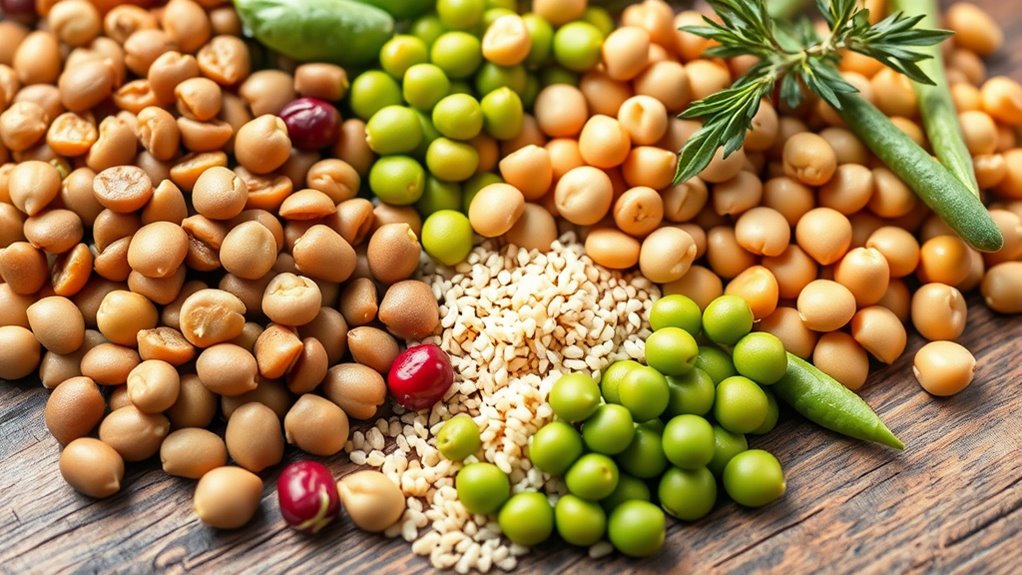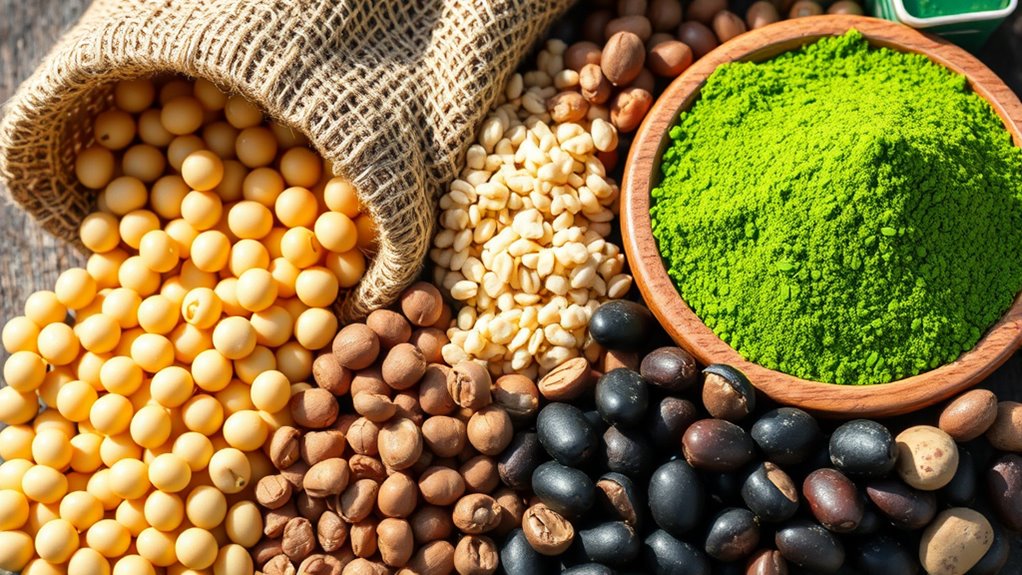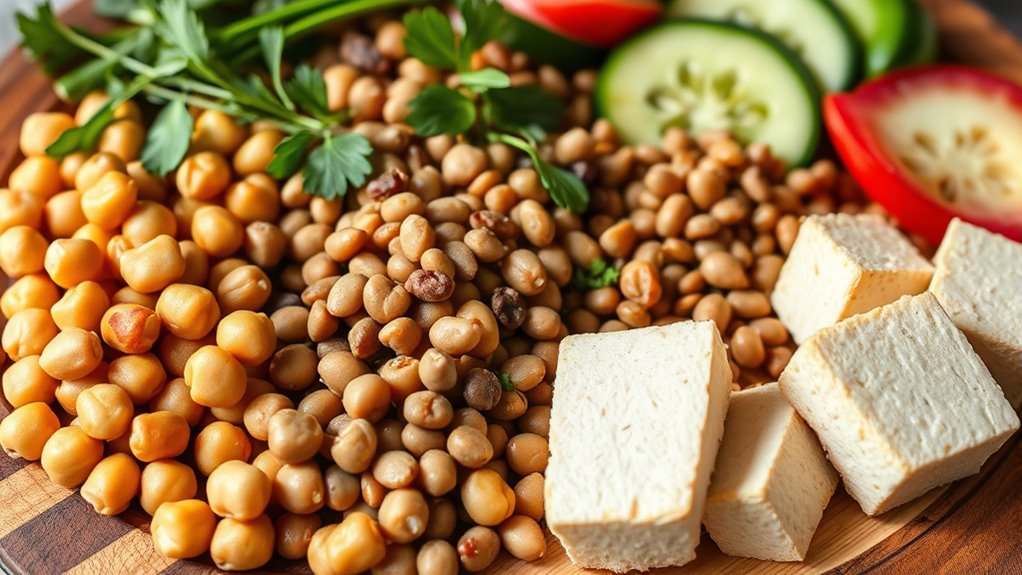Plant-based proteins can be complete or incomplete, depending on their amino acid profile. Complete proteins, like quinoa, soy, and hemp, contain all nine essential amino acids your body needs. Incomplete proteins, such as beans, nuts, and seeds, lack some amino acids but can be combined with other sources to form complete profiles. Understanding these differences helps you plan balanced plant-based meals—keep exploring for expert tips to optimize your nutrition.
Key Takeaways
- Complete plant proteins contain all nine essential amino acids, while incomplete proteins lack one or more of these amino acids.
- Quinoa, soy, chia, and hemp are examples of complete plant proteins; most legumes and nuts are incomplete.
- Combining different plant sources, like grains and legumes, creates a complete amino acid profile.
- Proper pairing or consumption of diverse plant foods throughout the day ensures adequate protein quality.
- No single plant food must provide all amino acids at once; dietary variety ensures nutritional completeness.
Understanding Essential Amino Acids and Protein Quality

Have you ever wondered what makes some proteins more valuable than others? It all comes down to essential amino acids—those your body can’t produce on its own. Proteins are made up of amino acids, but only nine are essential. The quality of a protein depends on how many of these essential amino acids it contains and how well your body can absorb and use them. Complete proteins supply all nine essential amino acids in adequate amounts, making them higher quality. In contrast, incomplete proteins lack one or more of these amino acids. Recognizing this helps you choose plant-based sources that meet your nutritional needs. High-quality plant proteins often combine different sources to provide a complete amino acid profile, ensuring your body gets what it needs for muscle repair, enzyme production, and overall health. Additionally, understanding protein quality can help you optimize your diet for better health and performance.
Common Plant Sources of Complete Proteins

While many plant-based foods are incomplete proteins, some offer complete sources of all nine essential amino acids. Quinoa is a prime example, providing a balanced amino acid profile and making it a versatile grain for your diet. Soybeans and soy products like tofu, tempeh, and edamame are also complete proteins, offering high-quality plant-based options. Buckwheat is another, despite its name, providing all necessary amino acids and fitting well into various dishes. Chia seeds and hemp seeds are nutrient-dense sources of complete proteins, easily added to smoothies or cereals. These foods help you meet your protein needs without relying on animal products, supporting a plant-based lifestyle while ensuring you consume all essential amino acids in your diet. Recognizing amino acid profiles in plant foods can help you create balanced meals that meet your nutritional needs.
Common Plant Sources of Incomplete Proteins

Legumes, beans, nuts, and seeds are common plant sources of incomplete proteins. These foods provide valuable nutrients but often lack certain essential amino acids. Understanding their limitations helps you plan a balanced and nutritious plant-based diet.
Legumes and Beans
Are legumes and beans truly complete sources of protein? Not quite. While they are excellent plant-based protein sources, most contain all essential amino acids in lower amounts, making them incomplete proteins. Common varieties like lentils, chickpeas, black beans, and kidney beans provide crucial nutrients, fiber, and plant-based protein, but lack sufficient levels of one or more essential amino acids, such as methionine or lysine. This means, on their own, they don’t supply a full amino acid profile. However, combining legumes with other plant foods—like grains or seeds—can create a complete protein profile. Including a variety of plant sources ensures you get all essential amino acids, supporting balanced nutrition on a plant-based diet. Additionally, understanding city dynamics can help optimize your nutritional choices in different environments.
Nuts and Seeds
Did you know that nuts and seeds are popular plant-based protein sources, yet they are generally considered incomplete proteins? They contain valuable nutrients and healthy fats, making them a nutritious addition to your diet. However, unlike complete proteins, nuts and seeds lack all nine essential amino acids in sufficient amounts. For example, almonds and sunflower seeds are rich in protein but often fall short on lysine, while chia seeds provide some amino acids but are incomplete overall. To guarantee you’re getting all essential amino acids, combine nuts and seeds with other plant foods like legumes or grains. Incorporating a variety of these sources helps you create balanced meals and meets your nutritional needs more effectively. Additionally, understanding protein quality can help you make better dietary choices to ensure complete amino acid intake.
Combining Plant Proteins for a Complete Amino Acid Profile

You can improve your plant-based diet by combining different protein sources that complement each other’s amino acids. Timing your consumption and pairing foods strategically guarantees you get a complete profile throughout the day. Focus on smart plant pairing strategies to maximize your protein intake effectively. For instance, incorporating Vetted electric bike conversion kits can motivate you to stay active and maintain a balanced lifestyle that supports your nutritional goals.
Complementary Protein Sources
While many plant-based proteins lack one or more essential amino acids, combining different sources can create a complete amino acid profile. You can mix foods like beans and rice, hummus and whole wheat bread, or peanut butter with whole grain toast to guarantee you get all essential amino acids. This approach is simple and effective, especially if you’re vegetarian or vegan. By pairing complementary proteins, you maximize nutrient intake without relying on animal products. Keep in mind:
- Combining grains and legumes is a classic strategy
- Variety throughout the day boosts amino acid coverage
- No need to consume all proteins in a single meal; spreading intake works too
- Gear shifting techniques used on bikes, such as anticipating terrain changes and shifting smoothly, can be compared to balancing nutrient intake over time to optimize health.
This method allows you to enjoy diverse plant-based foods while meeting your protein needs efficiently.
Timing of Consumption
Timing plays a pivotal role in maximizing the benefits of combining plant proteins. To guarantee your body efficiently uses amino acids, aim to consume complementary proteins within the same meal or close together. When you eat these foods together, your digestive system can better absorb a complete amino acid profile, supporting muscle repair and overall health. If you can’t combine proteins at a single meal, spreading them out throughout the day still provides benefits, as your body can pool amino acids over time. However, waiting too long between consumption of different plant proteins may reduce their synergistic effect. Ultimately, timely pairing helps optimize protein quality and ensures your body gets the essential amino acids it needs for proper functioning. Incorporating protein quality considerations like high-quality plant sources can further enhance your protein intake.
Plant Pairing Strategies
Combining plant proteins is essential for ensuring you get a complete set of essential amino acids, especially since most plant-based sources lack one or more of these nutrients. To maximize protein quality, you can pair different plant foods strategically. For example, combining grains with legumes creates a complete amino acid profile. You can also mix nuts or seeds with beans, or pair soy products with other vegetables. The key is to think variety and balance throughout your meals. Additionally, incorporating vertical storage solutions can help you organize a variety of plant-based ingredients for easy access and meal prep.
Myths and Facts About Plant-Based Protein Completeness

Many people believe that plant-based proteins can’t provide all essential amino acids, but this isn’t true. While some plant sources may have lower levels of certain amino acids, eating a varied diet ensures you get everything your body needs. Combining different plant proteins throughout the day—like beans with grains—can create a complete amino acid profile. Popular myths suggest you need animal products for complete protein, but plant-based diets can meet all nutrient requirements with proper planning. Legumes, quinoa, soy, and chia seeds are excellent sources of complete proteins. The key is diversity; no single plant protein needs to supply all amino acids at once. Additionally, advancements in AI in Education are enhancing personalized learning experiences that can support nutritional education. By including a variety of plant foods, you can confidently meet your protein needs without relying on animal products.
Tips for Optimizing Plant-Based Protein Intake

To maximize your plant-based protein intake, focus on incorporating a variety of protein-rich foods into your daily meals. This guarantees you get a broad spectrum of amino acids and prevents nutritional gaps. Combine different plant proteins throughout the day, such as beans, grains, nuts, and seeds, to improve protein quality. Also, consider meal planning to balance sources and avoid relying on a single food. Incorporating Vetted – Mother Baby Kids products can help ensure safety and quality in your dietary choices. Here are some tips to help you optimize your intake: – Incorporate legumes and whole grains in every meal – Use nuts and seeds as snacks or toppings – Experiment with plant-based protein powders or fortified foods
Frequently Asked Questions
Are Plant-Based Proteins Suitable for Athletes and Bodybuilders?
You’re wondering if plant-based proteins work for athletes and bodybuilders. They absolutely can, as long as you choose a variety of sources to get all essential amino acids. Combining foods like beans, rice, and nuts guarantees you meet your protein needs for muscle growth and recovery. With proper planning, plant-based proteins are a nutritious, sustainable option that supports your training goals just as well as animal proteins.
How Does Cooking Affect Plant Protein Completeness?
Imagine your plant proteins transforming into supercharged powerhouses with a simple cook! Cooking breaks down tough plant fibers, making amino acids more accessible and boosting protein digestibility. While it doesn’t turn incomplete proteins into complete ones, it enhances their nutritional quality, ensuring you absorb more essential amino acids. So, yes, cooking can make your plant-based proteins more effective, helping you fuel your active lifestyle better.
Can Vegans Meet All Essential Amino Acids Daily?
You can absolutely meet all your essential amino acids daily as a vegan. By eating a varied diet that includes different plant protein sources like beans, lentils, grains, nuts, and seeds, you guarantee you’re getting a complete amino acid profile. Combining foods throughout the day, such as rice with beans, helps fill any gaps. So, with thoughtful planning, your plant-based diet can provide all the nutrients your body needs.
What Are the Environmental Benefits of Plant-Based Proteins?
You can enjoy environmental benefits by choosing plant-based proteins, as they typically require less land, water, and energy than animal products. This shift reduces greenhouse gas emissions and helps conserve natural resources. By incorporating more plant proteins into your diet, you’re supporting sustainable agriculture and lowering your carbon footprint. Your choices directly contribute to a healthier planet, making it easier to promote environmental conservation through simple dietary adjustments.
Are There Any Allergies Related to Common Plant Protein Sources?
You might be concerned about allergies from common plant protein sources. Some people are allergic to soy, which is a popular plant-based protein, leading to reactions like hives or digestive issues. Others may react to peas or nuts, which are also used in plant-based products. It’s important to check ingredient labels and consult with a healthcare professional if you suspect a food allergy. Always test new foods cautiously.
Conclusion
Now that you know the secrets behind plant proteins, are you ready to unleash their full potential? With the right combinations and strategies, you can create complete, nutritious meals that support your health and sustainability goals. But there’s more to discover—hidden truths and surprising benefits waiting to be uncovered. Will you take the next step and transform your plant-based journey? The choice is yours, and your future self will thank you.









